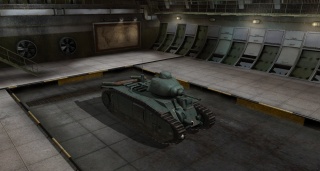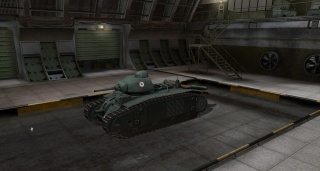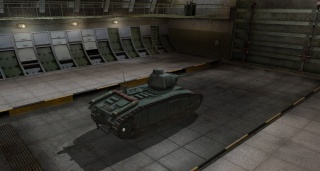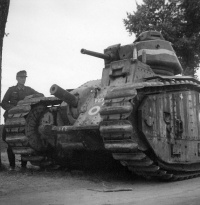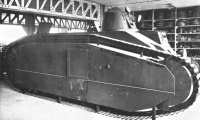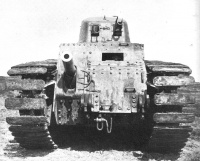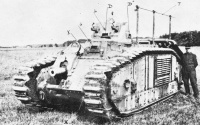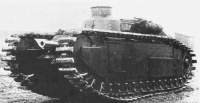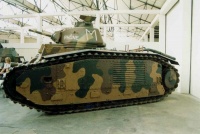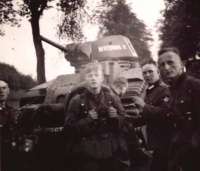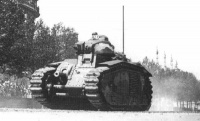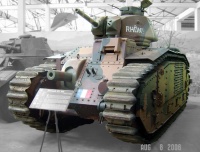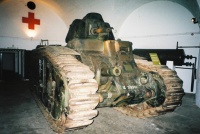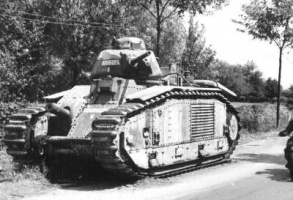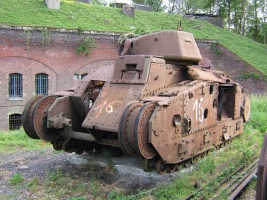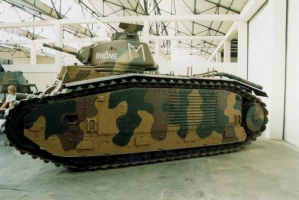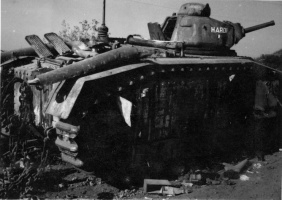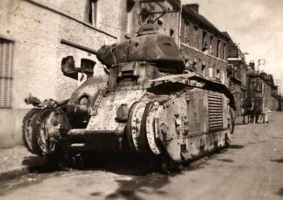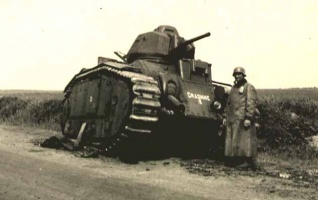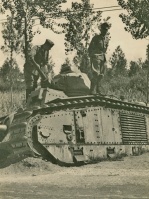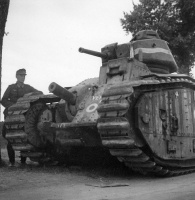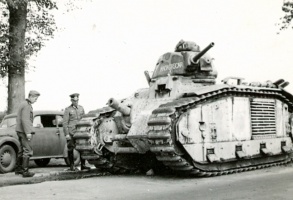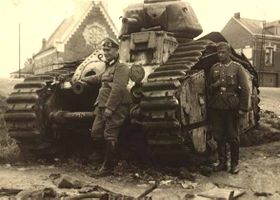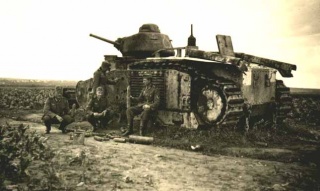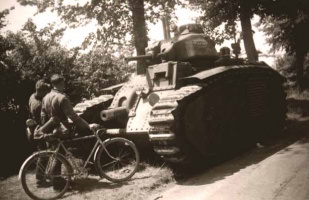B1
| Revision as of 14:57, 7 January 2015 historical accuracy | Revision as of 15:33, 16 February 2015 historical accuracy | |||
| Line 178: | Line 178: | |||
| |HistAcc= | |HistAcc= | |||
| ? | The B1's | + | The B1's only turret armaments were the 47 mm SA34 and SA35 gun. | |
| + | *The 47 mm SA37 was developed only for the Somua S40 which required an enlarged three-man turret. | |||
| + | *One of the B1's historical armaments, the 75mm ABS SA35 howitzer, is missing. Though visible in the hull front, it is unusable. | |||
| |Ref_references= | |Ref_references= | |||
Revision as of 15:33, 16 February 2015
<value_unset_error>
Mouse over "
[Client Values; Actual values in
| 0 |
| health Hit Points |
| 0/0Expression error: Unexpected < operator./Expression error: Unrecognized word "unable". t Weight Limit |
| engine Engine Power |
| / km/h Speed Limit |
| traverse Traverse |
| Expression error: Unexpected < operator.Expression error: Unexpected < operator. hp/t Power/Wt Ratio |
| NoNo Pivot |
| // mm Hull Armor |
| //Unable to match configuration for query: turret:b1::top|armorturretfront/Unable to match configuration for query: turret:b1::top|armorturretside/Unable to match configuration for query: turret:b1::top|armorturretback mm Turret Armor |
0/0/0
0/0/0 Shell Cost |
| //Unable to match configuration for query: gun:b1::top|damage1/Unable to match configuration for query: gun:b1::top|damage2/Unable to match configuration for query: gun:b1::top|damage3 HP Damage |
| //Unable to match configuration for query: gun:b1::top|penetration1/Unable to match configuration for query: gun:b1::top|penetration2/Unable to match configuration for query: gun:b1::top|penetration3 mm Penetration |
|
Expression error: Unrecognized word "unable". r/m ▲
Expression error: Unrecognized word "unable". r/m Magazine-fed Gun ▲ Rate of Fire Magazine-fed Gun |
|
Expression error: Unrecognized word "unable". ▲
Magazine-fed Gun
▼
Magazine-fed Gun
▲
Expression error: Unrecognized word "unable". Magazine-fed Gun
▲
Magazine-fed Gun
▼
Magazine-fed Gun
▲ Damage Per Minute Magazine-fed Gun
|
|
Expression error: Unrecognized word "unable". m ▲
Expression error: Unrecognized word "unable". m With 50% Crew: Expression error: Unexpected < operator. m ▲ Accuracy With 50% Crew: Expression error: Unexpected < operator. m |
|
Expression error: Unrecognized word "unable". s ▲
Expression error: Unrecognized word "unable". s With 50% Crew: Expression error: Unexpected < operator. s ▲ Aim time With 50% Crew: Expression error: Unexpected < operator. s |
| Unable to match configuration for query: turret:b1::stock|turrettraverseUnable to match configuration for query: turret:b1::top|turrettraverse deg/s Turret Traverse |
| 0° Gun Arc |
| -°/+°-Unable to match configuration for query: gun:b1::top|depression°/+Unable to match configuration for query: gun:b1::top|elevation° Elevation Arc |
| Unable to match configuration for query: gun:b1::stock|maxammoUnable to match configuration for query: gun:b1::top|maxammo rounds Ammo Capacity |
| Expression error: Unrecognized word "unable".Expression error: Unrecognized word "unable". % Chance of Fire |
|
Unable to match configuration for query: turret:b1::stock|viewrange m ▲
Unable to match configuration for query: turret:b1::top|viewrange m With 50% Crew: Expression error: Unexpected < operator. m ▲ View Range With 50% Crew: Expression error: Unexpected < operator. m |
|
Unable to match configuration for query: radio:b1::stock|distance m ▲
Unable to match configuration for query: radio:b1::top|distance m With 50% Crew: Expression error: Unexpected < operator. m ▲ Signal Range With 50% Crew: Expression error: Unexpected < operator. m |
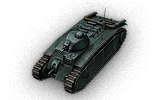
0
The <value_unset_error> is a [[|]] tier .
<value_unset_error>
The B1 is one of the lowest-tier heavy tanks available to the player, the other being the Durchbruchswagen 2. Its armour is great all-around for its tier, though thinner than the Matilda's and not as well sloped as the AMX 40’s. However, it is far more fast and manoeuvrable than both of those tanks. This allows you easily angle, re-angle and relocate as you need to with ease. Angling is near-essential for this tank to do really well. The side armour is as thick as the front's (60mm), but the front has two easy-to-hit weak spots of only 45mm (hull gun and driver window). Its main weakness is its penetration (66mm), which, while able to penetrate almost all tanks in a tier 4 game (the Matilda being the main worry for B1 drivers), it can hold it back a lot in tier 5 games. Thankfully, as a tier 4 heavy, tier 5 games are the worst this tank can see. In tier 4 matches, played well, the B1 can be really fun and regularly carry games. Don't overlook the B1's high RoF, surprisingly good armour, and its vast HP pool, the highest of any tier 4.
The <value_unset_error> marks the end of its line.
Modules / Available Equipment and Consumables
Player Opinion
Pros and Cons
Pros:
- Very high rate of fire and quick aim time
- Has premium matchmaking (Never sees tier 6 battles, like many premium tanks)
- Most hitpoints out of any tier 4 (With the second turret) with 420 HP
- Good all-round armour, though not as good as the Matilda's and AMX 40's
- Large ammo capacity
Cons:
- Relatively poor penetration
- Unusable hull gun becomes a liability, as it creates a large weakspot, along with the driver window
- Large silhouette and very long
- Bad view range
- Tracks do not absorb many shots
Performance
The B1 is very formidable against tanks at and below its tier. It is well-protected on all sides and is equipped with a rapid-firing and quick-aiming gun that makes short work out of weaker tanks. The hull is relatively strong and can be angled to further increase its armor effectiveness. The B1 also has a great turret traverse speed which easily keeps up with circling enemy tanks. This turret is also positioned towards the front of the tank which aids in hiding the B1's long and large hull. The turret is also small and equally-thick on all sides, though it's not as well-protected as the hull. Furthermore, the B1 has the highest hitpoint pool for its tier which comes in handy when its armor isn't enough.
A fast-firing gun, large hitpoint pool, and formidable armor allow the B1, when matched as a top tier tank, to wreck havoc among the enemy team. However, the B1 quickly becomes less effective against tier 5 enemies. Its armor becomes more easily penetrated and its own gun's penetration becomes very lacking. Other heavily-armored tier 4s such as the Matilda, AMX 40, and other B1s also pose a significant problem, thus it is recommended to carry a few premium rounds if one expects to engage heavily armored tier 5 vehicles. Furthermore, most tier 5s can easily destroy a B1 in a few shots. In this case, use your HP and fast-firing gun to draw enemy fire away from your allies. However, one of the best traits of the B1 is its adjusted matchmaking; the B1 will, thankfully, never face tier 6 enemies.
By using reverse-angling tactics you are able to take advantage of the B1's long hull and front mounted turret allowing you to peak and fire around corners without exposing your easily penetrated hull gun. However, you can still be penetrated from the turret, so be careful.
Early Research
- The guns and the ER 53 radio carries over from the D2
- Research the turret to mount the 47mm SA37
- Research the engines
- Research the suspension to gain XP for the next tank
- Go from there.
Suggested Equipment
Gallery
Historical Info
The Char B1 was a French heavy tank manufactured before World War II. It was a specialised heavy break-through vehicle, originally conceived as a self-propelled gun with a 75 mm howitzer in the hull; later a 47 mm gun in a turret was added, to allow it to function also as a Char de Bataille, a "battle tank" fighting enemy armour, equipping the armoured divisions of the Infantry Arm. Starting in the early twenties, its development and production were repeatedly delayed, resulting in a vehicle that was both technologically complex and expensive, and already obsolescent when real mass-production of a derived version, the Char B1 "bis", started in the late thirties. Although a second uparmoured version, the Char B1 "ter", was developed, only two prototypes were built. Among the most powerfully armed and armoured tanks of its day, the type was very effective in direct confrontations with German armour in 1940 during the Battle of France, but slow speed and high fuel consumption made it ill-adapted to the war of movement then being fought. After the defeat of France captured Char B1 (bis) would be used by Germany, with some rebuilt as flamethrowers or mechanised artillery.
Development history
Different concepts
The Char B1 had its origins in the concept of a Char de Bataille conceived by General Jean Baptiste Eugène Estienne in 1919, e.g. in his memorandum Mémoire sur les missions des chars blindés en campagne. It had to be a "Battle Tank" that would be able to accomplish a breakthrough of the enemy line by destroying fortifications, gun emplacements and opposing tanks. In January 1921 a commission headed by General Edmond Buat initiated a project for such a vehicle. To limit costs, it had to be built like a self-propelled gun, with the main weapon in the hull. To minimise the vehicle size this gun should only be able to move up and down with the horizontal aiming to be provided by turning the entire vehicle. The specifications included: a maximum weight of thirteen metric tonnes; a maximum armour thickness of 25 millimetres; a hull as low as possible to enable the gun to fire into vision slits of bunkers; a small machine gun turret to beat off enemy infantry attacks, at the same time serving as an observation post for the commander and a crew of at most three men. Two versions should be built, the one a close support tank armed with a 75 mm howitzer, the other an antitank-vehicle with a 47 mm gun instead. The French industry was very interested in the project. In the past this had often led to much non-constructive rivalry. Estienne, who in the war had personally witnessed the dismal effects of such a situation, was determined to avoid a repetition this time. He used his position as Inspector-General of the Tanks to enforce the so-called "Estienne accord" on the industrialists, ordering them to "reach a mutual understanding, free from any spirit of industrial competition". To be allowed to join they had to agree beforehand to relinquish any patents to the Army, which would be free to combine all projects into a single type. In exchange industry were promised very large orders of no less than a thousand vehicles.
On these conditions four projects were started in 1921: two by a cooperation between Renault and Schneider: the SRA and the SRB, one by FAMH (Forges et Aciéries de la Marine et d'Homécourt, better known as Saint Chamond) and the last by FCM (Forges et Chantiers de la Méditerranée), the FCM 21. Renault and Schneider would each get to produce 250 units, FAMH and FCM each 125. A fifth producer, Delaunay-Belleville, of which the project (an improved FT 17) had been rejected beforehand, would be allowed to make 83 tanks; the remaining 167 would be allotted at the discretion of the French State. On 13 May 1924 the four prototypes were presented at the Atelier de Rueil, where they were compared, each having to drive over a twenty kilometre test course. Immediately it became evident that their technical development had been insufficient, most breaking down; the SRA even started to fall apart. Maintenance was difficult because the engines were inaccessible. All projects used a three men crew but differed considerably in size, form and the solution chosen to laterally point the gun.
First prototypes
The SRA prototype was the heaviest vehicle with 19.5 metric tonnes. Its length was 595 centimetres, its height 226 cm and its width 249 cm. It had a 75 mm howitzer in the right side of the hull and a cast, 30 mm thick, turret with two machine-guns. It was steered by an epicyclical transmission combined with hydraulically reinforced brake disks—during tests this failed to provide the desired precision. Seen from the front it already was very similar to the final model, but its side view was more like that of the British Medium Mark D, including the snake track-system, with the drive wheel higher than the idler in front. The suspension used leaf springs. A Renault six-cylinder 180 hp engine (a bisected 12V aircraft engine) allowed for a maximum speed of 17.5 km/h; a four hundred litre fuel tank for a range of 140 kilometres.
The SRB prototype was a somewhat larger vehicle, six metres long, 228 centimetres high and 2,5 metres wide. It was nevertheless lighter at 18.5 tonnes, a result of having a smaller 47 mm gun—it thus was the antitank-version. Using the same engine, its speed was accordingly slightly higher at 18 km/h. More limited fuel reservoirs holding 370 litres decreased the range to 370 kilometres. It used an advanced hydraulic suspension system and the hydraulic Naeder-transmission from the Chaize company combined with a Fieux clutch and Schneider gear box. It used modified FT 17 tracks. The upper track run was much higher, creating enough room for a side door on the left. The FAHM prototype resembled the contemporary Vickers Medium Tank. It weighed seventeen tonnes, was 520 centimetres long, 240 cm high and 243 cm wide. It used a hydropneumatic suspension. Despite a weaker Panhard engine of 120 hp it still attained a speed of 18.2 km/h. Fuel reservoirs of just 230 litres limited its range to a mere seventy kilometres. The 75 mm howitzer was placed in the middle of the hull and steered by providing each snake track with its own hydraulic Jeanny transmission. On top was a riveted machine-gun turret with 25 mm armour.The FCM 21 prototype was the lightest prototype was at 15.64 tonnes. It resembled a scaled-down Char 2C, the giant tank produced by the same company. It was very elongated with a length of 6.5 metres and width of 205 centimetres. A rather large riveted turret with a stroboscopic cupola, adopted from the Char 2C, brought its height to 252 centimetres. Like the superheavy tank it had no real spring system for the twelve small wheels per side. Separate clutches for each snake track allowed to horizontally point the 75 mm howitzer in the middle of the hull. It used the same Panhard engine as the FAHM type and its speed was the lowest of all at 17.4 km/h. However, five hundred litre reservoirs allowed for the best range at 175 kilometres.
Slow development progress
March 1925 Estienne decided to base the future production type on the SRB, as regarded the general form and mechanical parts. However, it would be fitted with the 75 mm gun, a Holt-track to be developed by FCM, which company had completed a special research programme aimed at optimising weight distribution, and the FAMH-suspension (later this would again be discarded). Estienne also had some special desires: a track tension wheel should be fitted, adjustable from the inside, and a small gangway from the fighting room should improve the accessibility of the engine compartment. Furthermore the front armour should be increased to 40 millimetres. In November 1925 Renault was given the order to build a wooden mock-up, that was finished early 1926. On 27 January 1926 it was decided to build three prototypes of what was provisionally called a Tracteur 30, a final design by engineer Alleaume of the Schneider company, cooperating with the STCC (Section Technique des Chars de Combat). The first was to be delivered by Renault, the other two by FCM and FAHM respectively. The same year the Direction de l'Infanterie in the Plan 1926 redefined the concept of a Char de Bataille. There would be a greater emphasis on infantry support, implying that the antitank-capacity was secondary and no armour increase was necessary. The weight was to be limited to 22 metric tonnes and the speed might be as low as 15 km/h. However, a radio set would have to be fitted to better direct and coordinate its actions; therefore a fourth crew-member was needed. On 18 March 1927 the contracts for the three prototypes were signed. The hull of first Renault vehicle, made of softer boiler plate instead of armour steel to simplify changes, was in January 1929 finished apart from the armament. It was delivered in March. The separately produced cast turret was delivered on 23 April. The howitzer could only be fitted in April 1930. This prototype was allotted the series number N° 101. N° 102, the production of which FAMH had shifted to Renault, was delivered soon after; in September 1930 FCM delivered N° 103, constructed by the Atelier de Mépanti at Marseille. One of the vehicles was fitted with an alternative 75 mm Schneider gun instead of the 75 mm St Chamond M 21 from FAMH.
Trials and testing
Testing on the first prototype had already begun before the other two were delivered, or even its main armament was fitted. It had with 24,750 kilogrammes a weight higher than specified but could nevertheless reach a top speed of 24 km/h. From 6 May until August 1930 the Commission d'Experiences des Matériels de Chars carried out a further test programme on what was now officially called the Char B—the "B" not referring to Bataille but to a general classification code. The commission was largely satisfied with the vehicle, though many smaller problems were detected that had to be improved. The FCM prototype featured several alternative technologies: a Winterthur transmission, a Citroën clutch and a Sulzer diesel engine, later replaced by a Clerget diesel. All of these systems would prove to be more unreliable than the original concept and were ultimately rejected.
The three vehicles were not only used for technological but also tactical experimentations. Together with the Char D1 pre-series they represented the only modern tanks in France and the Army was naturally very interested in what lessons could be learned from them about future warfare, outlining the concept of a Char de Manoeuvre. Neither Char de Bataille nor Char de Manoeuvre are official type designations; they refer to the tactical concepts only.. In October 1931 a small unit was formed, the Détachement d' Experimentation in which the prototypes were united from December, using the Camp de Châlons as a base to see how they could be used in winter conditions. Afterwards they on their own power drove to the Atelier de Rueil for repairs. In September they participated in the Champagne summer manoeuvres as a Détachement Mécanique de Combat; from 4 May 1933 N° 102 en 103 together formed a Détachement d'Engins Blindés to perform tactical experiments in the army bases of Coëtquidan and Mourmelon as part of a motorised light division, followed by comparable experiments in April 1934 at Sissonne. Technical aspects were not forgotten during these tests and it was established they could attain an average road speed of 19 km/h, cross a trench 2,4 metres wide and wade through a 105 centimetres deep stream. The prototypes were again extensively altered to meet changes in specifications. On 6 April 1934 the first order was made for seven tanks of a Char B1. The "B1" refers to the fact that there were other simultaneous projects to develop improved types: the Char B2, B3 and B B.
Production
The Char B1 was manufactured by several firms: Renault (182), AMX (47), FCM (72), FAMH (70) and Schneider (32). Although it was the main producer, Renault had not exclusively designed the tank. Therefore the official name was not Renault B1 as often erroneously given. It was a very expensive tank to build: the per unit cost was about 1.5 million French francs. In France at the time two schools of thought collided: the first wanted to build very strong heavy tanks, the other a lot of cheap light tanks. Both sides managed to influence procurement policy to the end that not enough tanks were built of either category, to the exasperation of men like Colonel Charles de Gaulle who wanted to build more of the medium Char D2, with a third of the cost of the Char B1 bis, but armed with the same 47 mm gun.
Post WWI heritage
The outer appearance of the Char B1 reflected the fact that development started in the twenties: like the very first tank, the British Mark I tank of World War I fame, it still had large tracks going around the entire hull and large armour plates protecting the suspension—and like all tanks of that decade it had no welded or cast hull armour. The similarity resulted partly from the fact that the Char B1 was a specialised offensive weapon, a break-through tank optimised for punching a hole into strong defensive entrenchments, so it was designed with good trench-crossing capabilities. The French Army thought that dislodging the enemy from a key front sector would decide a campaign, and it prided itself on being the only army in the world having a sufficient number of adequately protected heavy tanks. The exploitation phase of a battle was seen as secondary and best carried out by controlled and methodical movement to ensure superiority in numbers, so for the heavy tanks also mobility was of secondary concern. Although the Char B1 had for the time of its conception a good speed, no serious efforts were made to improve it when much faster tanks appeared.
More important than the tank's limitations in tactical mobility, though, were its limitations in strategic mobility. The low practical range implied the need to refuel very often, limiting its operational capabilities. This again implied that the armoured divisions of the Infantry, the Divisions Cuirassées de Réserve, were—despite their name that merely reflected the fact that they had originally been planned to be raised in a secondary mobilisation—not very effective as a mobile reserve and thus lacked strategic flexibility. They were not created to fulfill such a role in the first place, which was reflected in the small size of the artillery and infantry components of the divisions.
The one-man turret
Another explanation of the similarity to the British Mark I lies in the Char B1's original specification to create a self-propelled gun able to destroy enemy infantry and artillery. The main weapon of the tank was its 75 mm howitzer, and the entire design of the vehicle was directed to making this gun as effective as possible. When in the early 1930s it became obvious that the Char B1 also had to defeat counterattacking enemy armour, it was too late for a complete redesign. The solution was to add the standard cast APX-1 turret which also equipped the Char D2. Like most French tanks of the period (the exception being the AMC 34 and AMC 35) the Char B thus had a small one-man turret. Today this is typically seen as one of their greatest flaws. The commander, alone in the turret, not only had to command the tank, but also to aim and load the gun. If he was a unit leader, he had to command his other tanks as well. This is in contrast with the contemporary German, British and Soviet policy to use two or three-man turret crews, in which these duties were divided amongst several men. The other nations felt that the commander would otherwise be over-tasked and unable to perform any of his roles as well as the commanders of tanks with two or three-man turret crews.
Whether this left the Char B1 less-formidable in actual combat than a review of its impressive statistics suggests, is difficult to ascertain. In 1940, the vast majority of Char B1 combat losses were inflicted by German artillery and anti-tank guns. In direct meetings with German tanks the Char B1 usually had the better of it, sometimes spectacularly so as when on 16 May a single tank, Eure, frontally attacked and destroyed thirteen German tanks lying in ambush in Stonne, all of them Panzer IIIs and Panzer IVs, in the course of a few minutes. The tank safely returned despite being hit 140 times. Similarly, in his book Panzer Leader, Heinz Guderian related an incident, which took place during a tank battle south of Juniville: "While the tank battle was in progress, I attempted, in vain, to destroy a Char B with a captured 47-mm anti-tank gun; all the shells I fired at it simply bounced harmlessly off its thick armor. Our 37-mm and 20-mm guns were equally ineffective against this adversary. As a result, we inevitably suffered sadly heavy casualties".
The French favoured small turrets despite their shortcomings, as they allowed for much smaller and thus cheaper vehicles. Although the French expenditure on tanks was relatively larger than the German, France simply lacked the production capacity to build a sufficient number of heavier tanks. The Char B1 was expensive enough as it was, eating up half of the infantry tank budget.
Variants
Char B1
The original Char B1 had frontal and side armour up to 40 mm thick. The vehicle had a fully traversing APX1 turret with a 47 mm L/27.6 SA 34 gun. This had a poor anti-tank capability: the thirty APHE (Armour Piercing High Explosive) rounds among the fifty the tank carried had a maximum penetration of about 25 mm. In addition, it was armed with a 75 mm ABS 1929 SA 35 gun mounted in the right-hand side of the hull front and two 7.5 mm Châtellerault M 1931 machine guns: one in the hull and the other in the turret. The 75 mm L/17.1 gun, that could fire both a HE and the APHE Obus de rupture Modèle 1910M round, had a limited traverse of only one degree to the left or the right (equating to about 18 metres at 500 m range). It was laid onto target by the driver (provided with the gun sight) through the Naeder hydraulic precision transmission. The traverse had only been made possible in order to precisely align the gun barrel with the sight beforehand. The 75 mm gun had its own loader—the remaining two crew members were the radio operator and the commander, who had to load, aim and fire the 47 mm gun while commanding the vehicle (as noted before, in the case of platoon leaders, command other vehicles as well). The fighting compartment had the radio set on the left and an exit hatch in the right side. All vehicles had the ER53 radio telegraphy set, which used Morse Code only, which proved not to be the best solution in combat. A hatch in the rear bulkhead gave access to a corridor (under which nineteen 75 mm rounds out of a total of eighty were stowed) in the engine room to the right of the engine, which was officially rated at 250 hp (190 kW), but had an actual output of 272 hp (203 kW). Each tank had its own team of three mechanics; in battle some of these might join the regular crew. The suspension was very complex with sixteen road wheels per side. There were three large central bogies, sprung by a vertical coil spring. Each central bogie carried two smaller ones. The three vertical springs moved through holes in a horizontal beam, to both extreme ends of which road wheels were attached by means of leaf springs: three at the front and one at the back. The high track run gave the tank an old fashioned look, reflecting its long development time. It had a maximum speed of 28 km/h and a weight of 28 metric tons. The range was about 200 km. A total of 34 vehicles were built from December 1935 until July 1937. They had series numbers 102 to 135. Chassis number 101 was kept apart to build the Char B1 ter prototype.
Char B1 bis
The Char B1 bis was an upgraded variant with thicker armour at 60 mm maximum (55 mm at the sides) and an APX4 turret with a longer-barrelled (L/32) 47 mm SA 35 gun, to give the tank a real anti-tank capacity. It was the main production type: from 8 April 1937 until June 1940 369 units were delivered out of a total order for 1144, with series numbers 201 to 569. Before the war manufacture was slow: only 129 had been delivered on 1 September 1939. The monthly delivery was still not more than fifteen in December; it peaked in March 1940 with 45 units. The Char B1 bis had a top speed of 25 km/h (16 mph) provided by a 307 bhp (229 kW) petrol engine. The first batch of 35 Char B1 bis used the original engine butfrom 1938 to May 1940 they were slowly re-equipped. Its weight was about 31.5 metric tons. The operational range was about 180 km which was similar to other tanks of the period. At 20 km/h the three fuel tanks (total capacity of 400) would be exhausted in six hours. To improve matters, at first, trailers with an 800 litre auxiliary fuel tank were towed but this practice was soon abandoned. Instead Char B1 units included a large number of fuel trucks and TRC Lorraine 37 L armoured tracked refuelling vehicles specially designed to quickly refuel them. The last tanks to be produced in June had an extra internal 170 l (37 imp gal) fuel tank. To cool the more powerful engine the Char B1 bis had the air intake on the left side enlarged. It is often claimed this formed a weak spot in the armour, based on a single incident on 16 May near Stonne where two German 37 mm PAK guns claimed to have knocked out three Char B1's by firing at the intakes at close range. The air intake was a 6-inch (150 mm) thick assembly of horizontal slits alternately angled upwards and downwards between 28 mm thick armour plates, and as such intended to be no more vulnerable than the normal 55 mm side plates. Over the production run the type was slowly improved. Tanks number 306 to 340 carried 62 47-mm rounds (and the old complement of 4,800 machine gun rounds); later tanks 72 and 5,250. However the B1 bis had fewer 75 mm rounds compared to the earlier B1 : 74 instead of eighty, normally only seven of which were APHE ammunition. Early in 1940 another change was made when the ER53 radio was replaced by the ER51 which allowed spoken wireless communication. The company and battalion command tanks also had an ER55 for communication with higher command. The crews of the 1re DCR kept their old sets however, preferring them because the human voice was drowned by engine noise.
Char B1 ter
The Char B1 ter, with sloped and welded 70 mm armour, a weight of 36.6 metric tons and an engine of 350 hp (260 kW) was meant to replace the B1 bis to accelerate mass production from the summer of 1940. Cost was reduced by omitting the complex Neader transmission and giving the hull gun a traverse of ten degrees instead. Only two prototypes could be finished before the defeat of France. In May 1940 it was agreed to deliver nine Char B1's each month to Britain in exchange for a monthly British production of the "H 39".
Operational history
The Char B1 served with the armoured divisions of the Infantry, the Divisions Cuirassées de Réserve. These were highly specialised offensive units, optimised to break through fortified enemy positions. The mobile phase of a battle was to be carried out by the armoured divisions of the Cavalry, equipped with the SOMUA S35. The First and Second DCR had 69 Char B1's each; the Third 68. The 37th Bataillon de Chars de Combat, serving with 1DCR, was at first equipped with the original B1; these vehicles were refitted with the longer SA 35 gun in the spring of 1940. The turret type designation was changed to APX1A. The battalion was re-equipped with the Char B1 bis and in May reinforced by five of the original tanks. After the German invasion several ad hoc units were formed: the 4DCR with 52 Char B1's and five autonomous companies (347e, 348e, 349e, 352e and 353e Compagnie Autonome de Chars) with in total 56 tanks: 12 B1's and 44 B1 bis. Also 28BCC was reconstituted with 34 tanks. The regular divisions destroyed quite a few German tanks, but lacked enough organic infantry and artillery to function as an effective mobile reserve. A number of Char B1's (161) were captured by the Germans during the Fall of France. These were later pressed into service as second line and training vehicles under the name of Panzerkampfwagen B-2 740 (f). Sixty became platforms for flamethrowers as Flammwagen auf Panzerkampfwagen B-2 (f). Sixteen were converted into 105 mm self propelled artillery. Ordinary tank versions were also frequently modified. For example, additional armour was placed above the main gun, and a winch mechanism was added behind the turret. One unit, Panzer-Abteilung 213, was equipped with the Char B1 bis and deployed on the Channel Islands from 1941 to 1945. One of their tanks is displayed by the Bovington Tank Museum, though repainted in French colours.
German use:
The principal German units that used the Char B1 bis.
• Panzer-Brigade 100
• Panzer-Regimente 100
• Panzer-Ersatz-Abteilung 100
• Panzer-Abteilung (F) 102
• Panzer-Abteilung 213
• SS-Panzer-Abteilung "Prinz Eugen"
• Panzer-Kompanie z.b.V. 12
• Panzer-Abteilung 223
• Beutepanzer-Kompanie 223
• I./Artillerie-Regiment 93 of 26. Panzer-Division
• II./Panzer-Regiment 1 of 1. Panzer-Division
• Panzer-Regiment 2 of 16. Panzer-Division
• I./Panzer-Regiment 36 of 14. Panzer-Division
• Panzer-Abteilung 205
• Panzer-Kompanie 206
• Panzer-Kompanie C (ND) 224
• Panzerjäger-Abteilung 657 (PK 224)
Surviving vehicles
Today eleven vehicles survive, one Char B1 and ten Char B1 bis.
The last surviving Char B1 can be seen at the "Association pour la Sauvegarde du Patrimoine Historique et Militaire" (ASPHM), near Strasbourg, in France. It was previously at the Fort de Seclin. It is in a bad condition, with parts like the main gun missing. It was salvaged from a firing range, but will be restored by the owner. A total of ten Char B1 bis tanks can be seen in various places in Great Britain and in France.
Historical Gallery
Historical Accuracy Errata
The B1's only turret armaments were the 47 mm SA34 and SA35 gun.
- The 47 mm SA37 was developed only for the Somua S40 which required an enlarged three-man turret.
- One of the B1's historical armaments, the 75mm ABS SA35 howitzer, is missing. Though visible in the hull front, it is unusable.
Sources and External Links
| Light Tanks | |
| Medium Tanks | |
| Heavy Tanks | |
| Tank Destroyers | |
| Self-Propelled Artillery |
| USA | |
| UK | |
| Germany | |
| France | |
| USSR | |
| China | |
| Japan | |
| Czechoslovakia | |
| Sweden | |
| Italy | |
| Poland |





